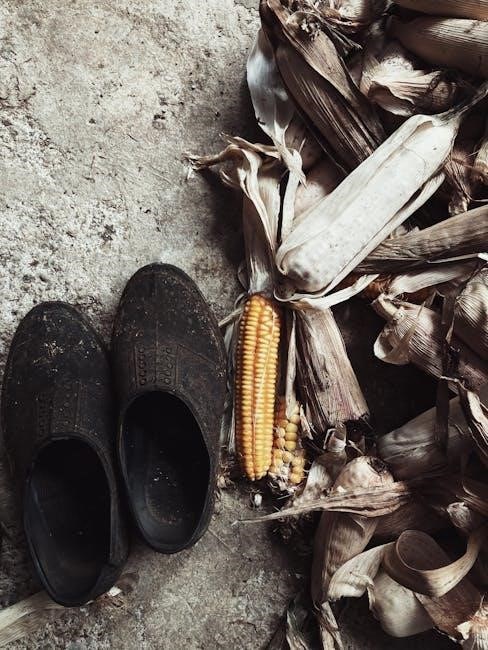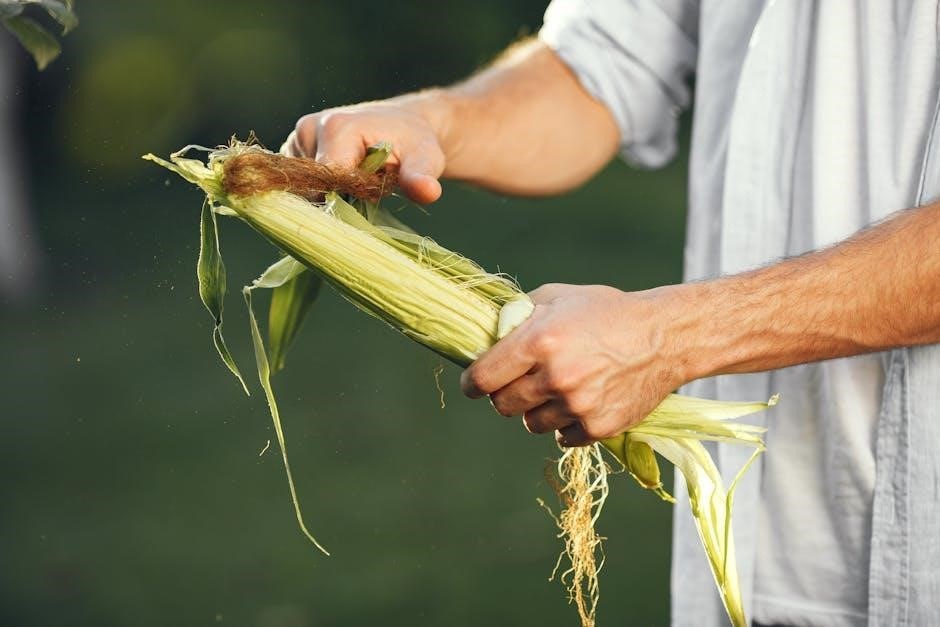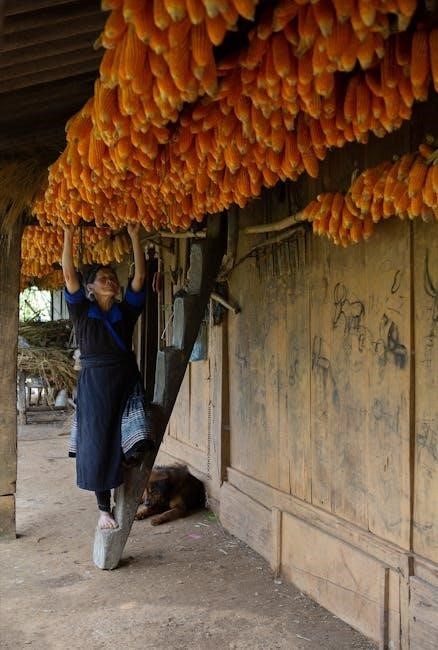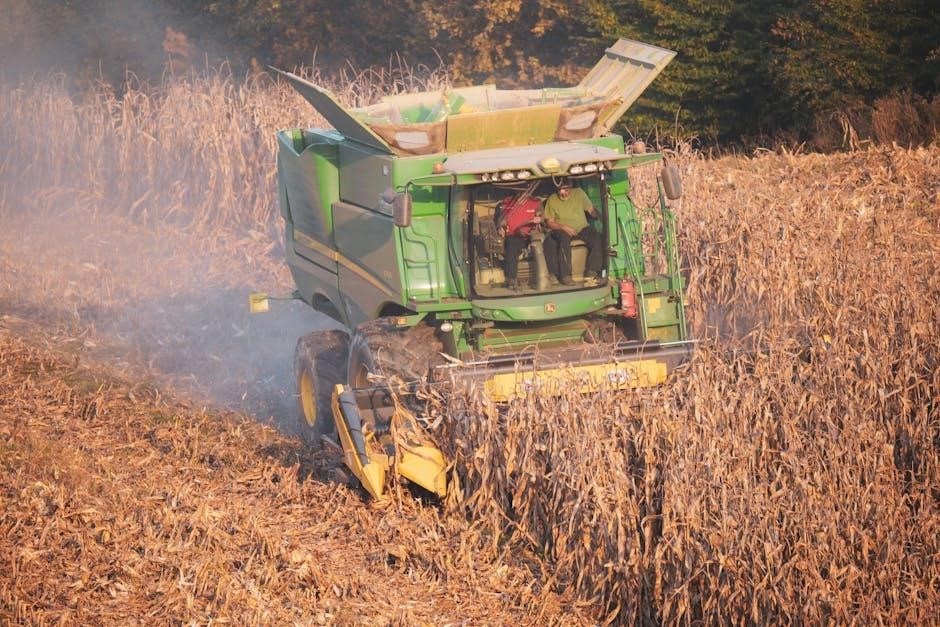The John Deere 7000 Corn Planter is a versatile, high-performance agricultural tool designed for efficient planting of corn and other crops. This manual provides essential guidance for optimal use, maintenance, and troubleshooting, ensuring maximum productivity and crop yields.

1.1 Overview of the JD 7000 Corn Planter Model
The JD 7000 Corn Planter is a high-efficiency, folding planter designed for precise corn and crop planting. Available in 12-, 16-, and 18-row configurations, it features John Deere’s Max-Emerge technology for consistent seed placement. This model is ideal for both conservation and conventional tillage systems, offering durability and reliability. With adjustable row spacing, planting depth, and seed spacing, it ensures optimal seed placement for maximum yield. The planter is supported by comprehensive manuals for operation, maintenance, and repair.
1;2 Key Features and Benefits
The JD 7000 Corn Planter offers advanced features like Max-Emerge row units, ensuring accurate seed placement and spacing. Its folding design allows easy transport and storage, while the robust frame provides durability. The planter supports various row configurations and is compatible with John Deere’s technology for real-time monitoring. Additional benefits include adjustable planting depth, seed metering systems, and integration with tractor controls, enhancing efficiency and productivity for farmers. Regular maintenance ensures optimal performance.

Safety Precautions and Guidelines
Always wear protective gear and follow safety guidelines when operating the JD 7000 Corn Planter. Ensure proper equipment inspection and use safety features like emergency stops.
2.1 General Safety Tips
Always wear protective gear, including gloves, safety glasses, and a hat, when operating or maintaining the JD 7000 Corn Planter. Ensure the area is clear of obstacles and bystanders before use. Regularly inspect all components for wear or damage to prevent malfunctions. Familiarize yourself with emergency stop locations and proper shutdown procedures. Follow all manufacturer guidelines and safety standards to minimize risks and ensure safe operation.
2.2 Safety Features of the JD 7000 Planter
The JD 7000 Corn Planter is equipped with multiple safety features to protect operators and ensure safe operation. These include automatic shut-off systems, emergency stop buttons, and protective guards to prevent accidental injuries. The planter also features rollover protection structures and alarm systems for fold and unfold operations. Regular maintenance checks are emphasized to ensure all safety mechanisms function correctly, providing a secure environment for operators during planting operations.
Preparing the Planter for Use
Preparing the JD 7000 planter involves initial setup, calibration, seed disk selection, and pre-planting checks to ensure optimal performance and accurate seed placement.
3.1 Initial Setup and Calibration
Initial setup of the JD 7000 planter requires careful calibration to ensure precise seed placement. Adjust the seed meters according to the crop type and desired planting rate. Use the provided seed disk selection guide to choose the correct disk for corn or other crops. Calibrate the planter’s downforce and spacing settings to match soil conditions and optimize seed germination. Proper setup ensures uniform emergence and maximizes yield potential. Regular checks and adjustments are crucial for consistent performance.
Before planting, inspect the planter’s seed meters, chains, and sprockets for wear. Lubricate all moving parts and ensure proper tension on drive chains. Check row units and closing wheels for damage or misalignment. Verify tire pressure and test-drive the planter to ensure smooth operation. Perform a final calibration and adjust as needed. Always refer to the manual for specific maintenance schedules and guidelines to ensure optimal performance and extend the planter’s lifespan. Regular checks help prevent downtime and ensure accurate seed placement.

Attaching the Planter to a Tractor
3.2 Pre-Planting Checks and Maintenance
Before planting, inspect the planter’s seed meters, chains, and sprockets for wear. Lubricate all moving parts and ensure proper tension on drive chains. Check row units and closing wheels for damage or misalignment. Verify tire pressure and test-drive the planter to ensure smooth operation. Perform a final calibration and adjust as needed. Regular maintenance helps prevent downtime and ensures accurate seed placement for optimal crop yields. Follow the manual’s guidelines for specific checks and adjustments.
4.1 Step-by-Step Attachment Process
To attach the John Deere 7000 Corn Planter to a tractor, align the planter’s hitch with the tractor’s drawbar. Secure the hitch pins firmly and connect the hydraulic lines. Attach the PTO shaft, ensuring proper alignment and engagement. Connect the electrical harness to the tractor’s system for monitor integration. Use the SCV TOUCHSET monitor to configure settings for optimal performance. Refer to page 50 of the manual for detailed diagrams and specific instructions for your tractor model. Proper alignment and secure connections are critical for safe operation.
4.2 Ensuring Proper Alignment and Connection
Proper alignment and connection are critical for safe and efficient operation. Align the planter’s hitch with the tractor’s drawbar, ensuring it is centered and secure. Tighten all hitch pins firmly and check hydraulic lines for proper connection. Inspect the PTO shaft for correct alignment and engagement. Connect the electrical harness to the tractor’s system, ensuring all sensors and monitors are functioning. Use the SCV TOUCHSET monitor to configure settings for precise operation. Refer to page 50 of the manual for detailed alignment and connection procedures. Proper setup prevents wear and ensures optimal planting performance.

Operating the Planter
The John Deere 7000 Corn Planter operates efficiently with precise seed placement and adjustable rates. Use the control console to monitor and adjust settings for optimal planting performance.
5.1 Understanding the Control Console

The control console of the John Deere 7000 Corn Planter is designed for intuitive operation, featuring a user-friendly interface. It allows precise monitoring of planting rates, seed depth, and row spacing. Operators can adjust settings easily, ensuring accurate seed placement. The console also provides real-time feedback, enabling timely adjustments for optimal planting performance. Regular checks and calibrations are essential to maintain accuracy and reliability during operation.
5.2 Folding and Transporting the Planter
Folding and transporting the John Deere 7000 Corn Planter requires careful attention to ensure safety and proper alignment. Use the hydraulic system to fold the wings securely, ensuring all rows align properly. Always engage transport locks to stabilize the planter during movement. When transporting, maintain a steady speed and ensure the planter is balanced. Regularly inspect the folding mechanisms and hydraulic connections for wear or damage to prevent malfunctions during operation or transport.
5.3 Unfolding and Positioning the Planter
To unfold and position the John Deere 7000 Corn Planter, begin by lowering the planter to the ground using the hydraulic system. Disengage the transport locks to allow the wings to unfold evenly. Use the control console to activate the hydraulic folding mechanism, ensuring the planter is on level ground for proper alignment. Once unfolded, adjust the planter’s position using guidelines or markers to ensure accuracy. Double-check all sections for alignment and consistent depth settings before initiating planting operations;
5.4 Planting Rates and Adjustments
The John Deere 7000 Corn Planter allows precise control over planting rates, ensuring optimal seed placement. Use the control console to monitor and adjust seed depth, spacing, and population. Different seed types may require specific settings, and field conditions like soil moisture and texture can influence adjustments. The manual provides guidance for optimizing these settings to achieve uniform germination and maximize yield. Regularly check and recalibrate to maintain consistent planting performance across varying field conditions.
5.5 Troubleshooting Common Issues
Common issues with the John Deere 7000 Corn Planter include seed blockages, inaccurate planting depth, and meter malfunctions. Check the seed meters for damage or debris and ensure proper calibration. Adjust the depth control based on soil conditions. For meter issues, refer to the manual for recalibration or replacement procedures. Use the control console to diagnose and resolve problems promptly to maintain planting efficiency and avoid crop yield losses. Regular maintenance can prevent many of these issues.

Maintenance and Repair
Regular maintenance is crucial for the John Deere 7000 Corn Planter’s performance. Follow the routine schedule for lubrication, inspection, and part replacement to prevent breakdowns and ensure optimal efficiency.
6.1 Routine Maintenance Schedule
The John Deere 7000 Corn Planter requires a structured maintenance routine to ensure longevity and efficiency. Daily checks include lubricating chains, inspecting seed meters, and cleaning residue. Weekly, examine and replace worn parts like sprockets and belts. Monthly, service the planter’s hydraulic system and check for alignment issues. Seasonal maintenance involves thorough inspection of frames, rows, and meters, ensuring all components are in optimal condition before planting.
6.2 Repair Procedures for Common Problems
Common issues with the John Deere 7000 Corn Planter include worn sprockets, misaligned seed meters, and faulty sensors. For sprocket replacement, remove the chain, install new sprockets, and adjust tension. Seed meter calibration involves checking vacuum settings and ensuring proper seed flow. Sensor malfunctions require diagnostic testing using John Deere’s electronic tools. Always use genuine parts and consult the manual for detailed step-by-step instructions. Regular repairs ensure optimal performance and prevent costly downtime during planting season.
Planting Rates and Optimization
The John Deere 7000 Corn Planter manual provides detailed guidance on optimizing planting rates for maximum yield. It covers seed selection, spacing adjustments, and depth settings.
7.1 Selecting the Right Seed and Settings
The John Deere 7000 Corn Planter manual emphasizes the importance of selecting the right seed type and adjusting planter settings for optimal performance. Proper seed size, shape, and variety must be considered to ensure accurate planting. The manual provides guidelines for adjusting seed meters, spacing, and depth based on specific seed characteristics and soil conditions. This ensures uniform germination and maximizes yield potential.
7.2 Adjusting Planting Rates for Optimal Yield
The John Deere 7000 Corn Planter manual provides detailed guidance on adjusting planting rates to maximize yield. Operators can fine-tune seed placement by calibrating row units and seed meters. The control console allows for precise adjustments to planting depth, spacing, and population. Regular monitoring of seed distribution and soil conditions ensures optimal results. Referencing the manual’s specifications ensures proper calibration for varying seed types and field conditions, promoting uniform germination and higher yields.
Parts and Accessories
The John Deere 7000 Corn Planter requires genuine parts for optimal performance. Essential components include row units, seed meters, and planter frames. Accessories like cultivator attachments and seed disks enhance functionality. Regularly replacing worn parts ensures longevity and efficiency. Refer to the manual for a detailed parts catalog and sourcing options.
8.1 Essential Parts for the JD 7000 Planter
The JD 7000 Planter requires specific components for optimal performance. Key parts include Max-Emerge row units, seed meters, planter frames, and drive chains. These ensure precise seed placement and uniform spacing. Additionally, finger pickup seed meters handle various seed sizes without adjustments. Regular inspection and replacement of worn parts, like sprockets and bearings, are crucial for maintaining planting accuracy and machine longevity. Genuine John Deere parts are recommended for reliability and compatibility.
8.2 Where to Source Genuine John Deere Parts
Genuine John Deere parts for the 7000 Planter are available through authorized dealerships and online platforms. The John Deere Parts Advisor tool helps identify and locate specific components efficiently. Additionally, official John Deere websites and catalogs provide detailed part numbers and descriptions. Purchasing from certified sources ensures authenticity and compatibility, maintaining the planter’s performance and warranty validity. Always verify seller credentials to avoid counterfeit products.
